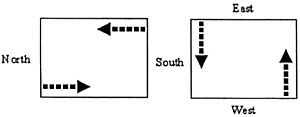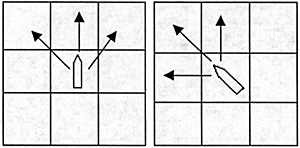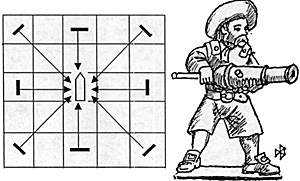 I. Objective
I. Objective
A. Victory is awarded to the side that inflicts more damage upon the opposing ships than it receives upon its own ships during the game.
B. The game may be ended in one of three ways:
- The easiest way to end a game is to play until all of the ships on one side have been sunk or
captured. No time-keeping, turn-recording, or total score is necessary to determine the winner when using this method. Or,
Set a time limit (e.g. 30 minutes with a kitchen timer) and total the score at the end. Or,
Roll 4 d6 to determine the number of turns in the engagement. Circle this number above the turn box at the top of the Damage Chart. Check off one turn box when both sides have finished a movement phase. The game ends when all the turns have been used. When the game ends, the score for each side will be totaled to determine the winner.
C. If the game is limited by time or turns, the score will be determined in the following manner:
- 1 point is awarded for each damage box checked in the opposing fleet on the Damage Chart.
If an opposing ship is sunk or captured, points are awarded for all of the damage boxes on that ship; e.g., a large ship=18; medium=12; small=6.
II. Equipment
A. The playing board is made of a poster board (28”x22”) divided into 2” squares.
B. Each side needs 5 similar ships.
- Both sides will use the same types of ships. (Each side could use 3 large, 1 medium, and 1 small ship; or, each side could use 5 large ships of the line; etc.)
After determining the kinds of ships to be used, write their names on the Damage Chart and draw lines through unnecessary rows of boxes in the rectangle. (See VI.B-E.)
(Exception: There can be different kinds and numbers of ships in a campaign.)
C. You will need a copy of the rules; a photocopied Damage Chart; a pencil; 3 red and 3 blue dice; 12 white cotton markers (Glue a small puff of cotton to a #8 washer to place beside the ships that fire.), and 6 cotton markers painted black to indicate ships that are dead-in-the water.
III. Wind
A. One short end of the playing board will be designated north and the opposite end will be south.
B. Roll 2 d6 to determine the direction from which the wind is blowing: 1= north; 2,3= northeast; 4= east; 5,6= southeast; 7= south; 8,9= southwest; 10= west; 11,12= northwest.
C. Put a marker (a bit of a Post It note with an arrow drawn on it) on the center of the playing board as a reminder of the wind direction.
D. It costs 2 movement points to enter a space while sailing directly into the wind.
 IV. Setup
IV. Setup
A. Roll 2 d6 to determine the direction from which the red side will enter the board: 1-3= north; 4-6= east; 7-9= south; 10-12= west.
B. The blue side will enter from the opposite direction. (See the diagram below.)
C. Place ships in a line-astern formation in the first five squares along the edge of the board.
D. Ships, large or small, may be placed in any order within the line-of-battle formation.
E. The line-astern formation may be abandoned anytime after play begins.
 V. Movement
V. Movement
A. You do not roll dice to move. Each ship begins the game with 3 movement points per turn, which will allow it to move into 3 squares. This movement may be reduced by sailing directly into the wind (III.D.) or by sustaining battle damage (VI.F.2.,3.,5.).
B. At the beginning of the game, roll a red and a blue die. The side with the high roll moves first.
C. Each side moves all of its ships during its turn.
D. Movement from one square to another must be directly ahead or diagonal. A ship may not make a 90-degree turn to the side or move backward.
E. The bow must be pointed the in same direction as the movement of the ship; i.e., if a ship moves into a square diagonally, it must be facing diagonally when it stops.
F. A ship that cannot complete all of its movement because it is blocked by other ships must attempt to board any enemy ship in front of it.
G. If a ship is not able to complete all of its movement without crossing the edge of the board, it is considered stuck on a shoal, dead-in-the-water. If captured, the captors can sail it off the shoal.
VI. Firing
A. Larger ships carried more guns—many of them were more powerful than the guns of smaller ships. Using more dice and longer firing distances for larger ships represents this difference.
| Ship | Range / Dice | ||
|---|---|---|---|
| 1 Square | 2 Squares | 3 Squares | |
| Large ship | 3 dice | 2 dice | 1 die |
| Medium ship | 2 dice | 1 die | - |
| Small ship | 1 die | - | - |
 B. Each d6 rolled by the firing ship indicates a miss or damage to a section of the target ship:
B. Each d6 rolled by the firing ship indicates a miss or damage to a section of the target ship:
- 1 = a miss
2-3= hull damage
4-5= rigging damage
6 = guns & crew damage.
C. All hits should be marked in the appropriate boxes of the target ship on the Damage Chart.
D. A ship may fire once during its movement phase and once during its defensive phase.
E. During its movement phase, a ship may fire anytime after moving one square. After deducting losses, the target ship may counter fire if it has not already fired during that phase.
F. Even if it is not attacked, a defending ship that has not fired during the current phase may fire at a moving ship when it comes within range. The moving ship will stop to be fired upon, deduct losses, and then complete its move.
G. Small puffs of cotton should be placed beside all ships which fire. These markers are moved with the ships until the end of the phase. At the end of the movement phase, all markers are removed. The process is repeated in the next movement phase of the turn.
H. To fire its guns, the attacking ship must be at a 90-degree angle to the target and the target must be within range. See the following diagram for the possible attack positions of a medium sized ship against a target.
VII. Damage Chart
A. Damage from gunfire and boarding is recorded on the Damage Chart.
B. Write the names of the ships on the lines above the rectangles containing 3 columns of boxes.
C. Each ship has three columns of boxes representing: Hull (H), Rigging (R) , Guns & Crew (G/C).
D. The number of boxes in each column represents the amount of damage the ship is able to absorb: large ships have 6 boxes, medium ships have 4 boxes, and small ships have 2 boxes.
E. When preparing the Damage Chart, draw a line through any boxes that are not needed; i.e., draw lines through the lower 2 rows of boxes for a medium-sized frigate, and the lower 4 rows for a small sloop. The large ships of the line keep all 6 rows of boxes.
F. Damage to various sections of the ship have the following effects:
- A ship is sunk when all of the HULL damage boxes are checked.
A ship’s movement is reduced by 1 square for each 2 damage checks to the RIGGING.
A ship is dead-in-the-water when all the RIGGING boxes are checked, but it may fight if boarded. (See VII.C.)
A ship loses 1 d6 roll for each 2 GUNS & CREW damage boxes checked.
A ship is dead-in-the-water when all GUNS & CREW boxes are checked and will surrender if boarded.
VIII. Boarding
A. A ship may board another ship by sailing into the same square. The boarding ship will be placed beside the target ship regardless of the angle of entry into the square. Any movement turns not expended by the boarding ship will be lost after entering the square.
B. A ship that is dead-in-the-water without gun and crew units (G/C) will surrender and may be boarded without a fight.
C. A ship with at least one gun and crew unit (G/C) may surrender or fight when boarded depending upon the roll of 1 d6: 1-3= surrender, 4-6= fight. Modify the roll as follows:
- Subtract 1 point from the die roll for each G/C unit less than the boarding ship’s. Or,
Add 1 point to the die roll for each G/C unit more than the boarding ship’s.
D. If fighting occurs, 1 d6 is rolled for each unit of crewmen (G/C) on board each ship. A roll of 4-6 destroys an opposing unit of crewmen. Check off the Gun/Crew unit on the Damage Chart.
E. After the casualties are checked off the Damage Chart, the boarded ship will roll again to see if it surrenders or continues to fight. The process continues until the ship surrenders or one side loses all of its crewmen (G/C). If the boarding ship loses all of its crew, it will be captured.
F. If opposing ships block the movement of a ship by occupying the only squares available for its movement, the moving ship must attempt to board one of the blocking ships.
IX. Capture
A. Captured crewmen cannot be used to sail the ship and should be marked off the Damage Chart
B. In order to sail and defend the captured ship, one or more units of crewmen must be transferred from the boarding ship to the captured ship. The unit(s) must be marked off the Gun and Crew (G/C) column of the capturing ship and given an unmarked G/C box in the captured ship’s column.
C. If the captured ship is not dead-in-the-water due to rigging damage, it should be sailed off the board anywhere along the edge from which its captor entered the game; e.g., if the capturing ship entered from the south, the captured ship must exit anywhere along the southern edge of the board.
D. If the captured ship is attacked before it can leave the board, it may continue to fight using the new guns and crewmen (G/C). The previous damage to the hull and rigging remains, however, and the opposing force may recapture the ship before it crosses the edge.
E. If the captured ship is dead-in-the-water due to damage to the rigging, it will remain where it is and the new crewmen may be used to fight off any attacks or attempts to recapture it before the game ends. The captor will receive all the victory points for the capture of the ship if retaining control of the vessel at the end of the game. All points for the ship will be lost if it is recaptured before the end of the game.
F. If a captured ship is sunk by either side for any reason, the captor still gets the complete number of victory points for the vessel.
G. When conducting a campaign, ships that are captured may be repaired, renamed, and used by the victor in the remainder of the games.
[Note: Watch for ships that are low on crewmen (G/C) and board them before the rigging is destroyed. Capturing ships and sailing them off the board will usually shorten the game.]
Fighting Rules for Sailing Ships
Back to Table of Contents -- Lone Warrior # 142
Back to Lone Warrior List of Issues
Back to MagWeb Magazine List
© Copyright 2003 by Solo Wargamers Association.
This article appears in MagWeb.com (Magazine Web) on the Internet World Wide Web.
Other military history articles and gaming articles are available at http://www.magweb.com
